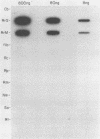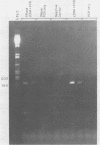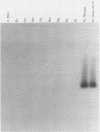Abstract
In an effort to explore a sensitive taxon-specific detection system for bacteria, we sequenced the 16S rRNA from two strains of Rickettsia rickettsii, five other rickettsiae, and Coxiella burnetti to find a probe site unique to R. rickettsii. We then synthesized a 16-mer that hybridized only to the rRNA of R. rickettsii. Using a primer complementary to a sequence found only in rickettsial rRNA, we then generated a cDNA. We amplified the probe site in a 180-base segment of the cDNA by using the cDNA primer and a second primer also unique to rickettsiae in a polymerase chain reaction. The segments of rRNA from each of the rickettsiae were amplified 10(6)- to 10(7)-fold, and the R. rickettsii probe hybridized only to the amplified segment from R. rickettsii. The rRNAs from Staphylococcus aureus, C. burnetii, and Neisseria meningitidis were not amplified and did not hybridize with the probe. The approach detailed below may prove clinically useful in the direct detection of pathogens that are difficult to cultivate.
Full text
PDF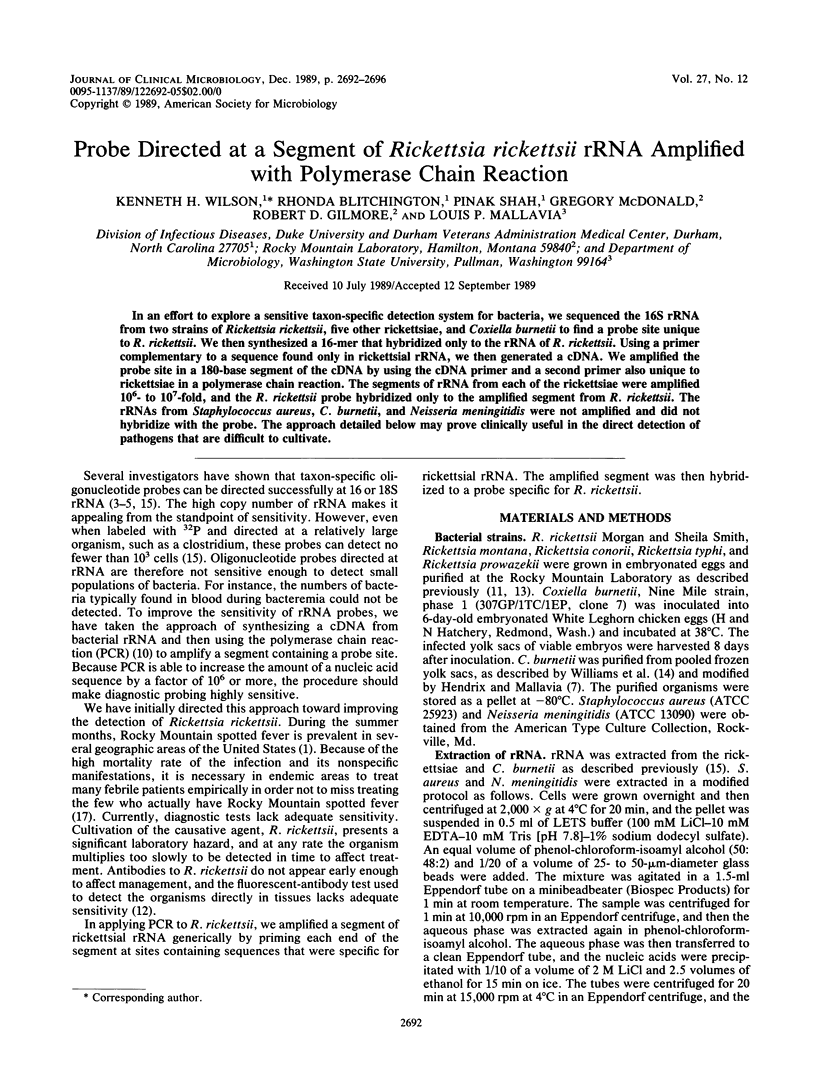
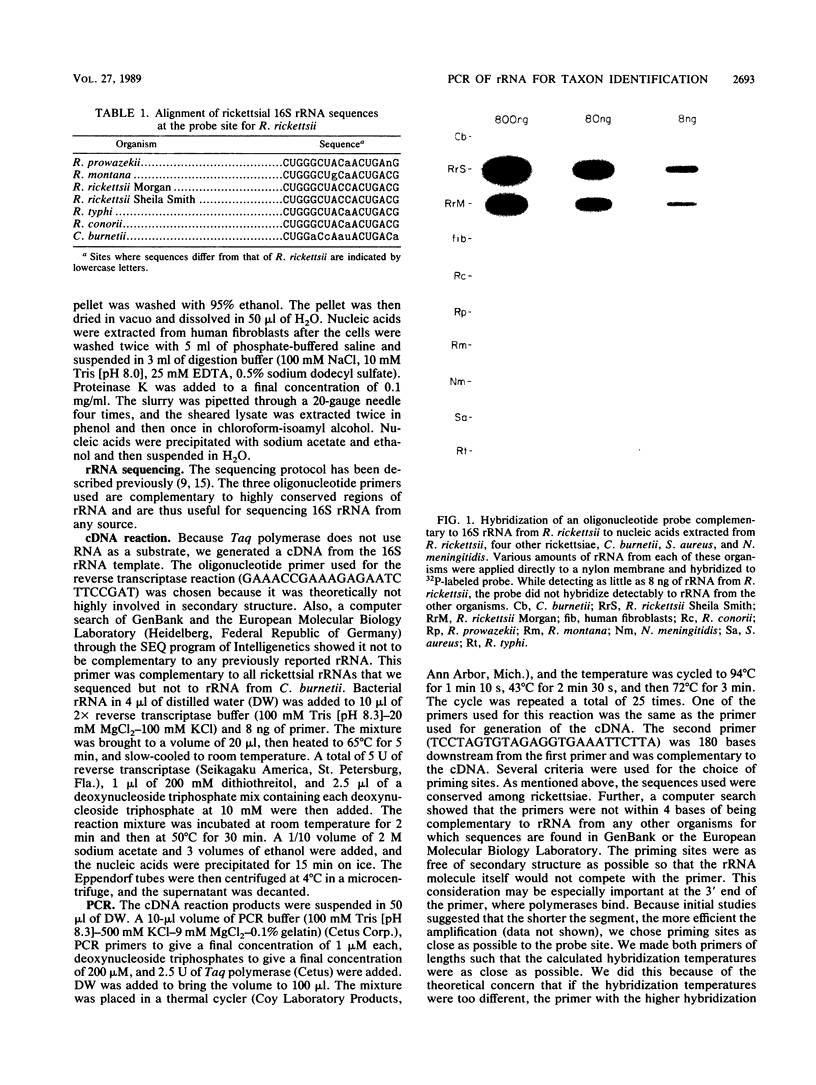
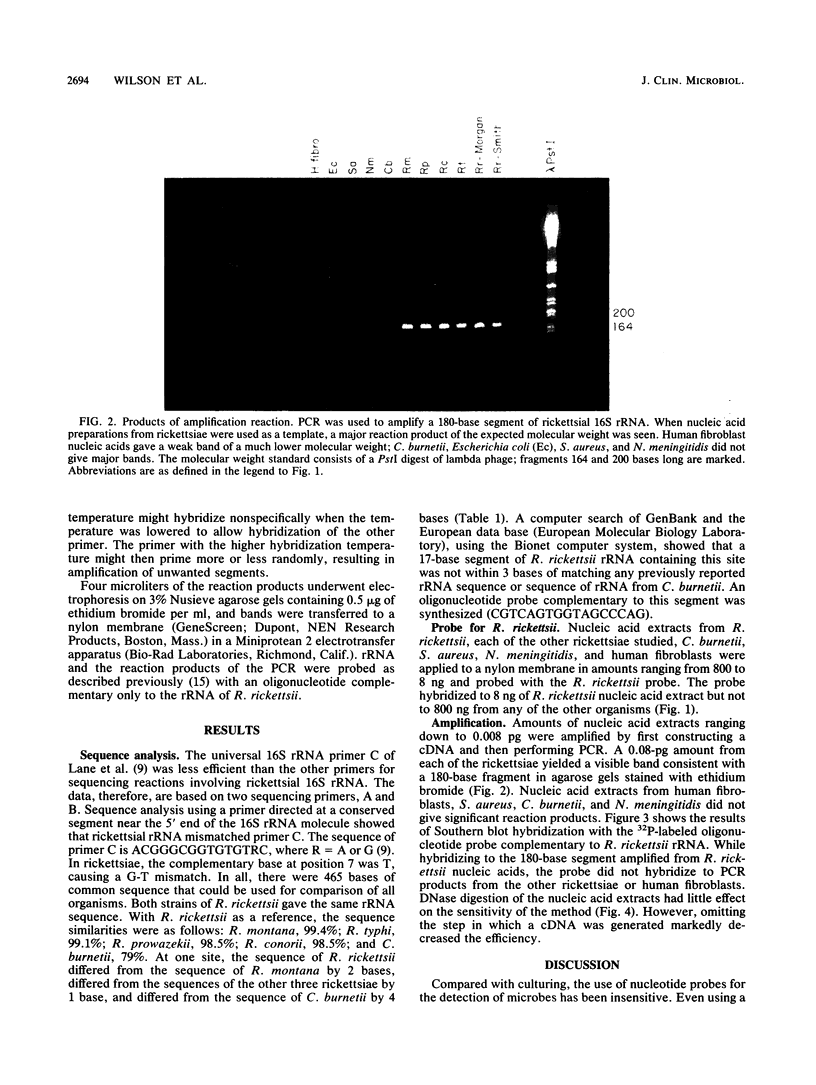
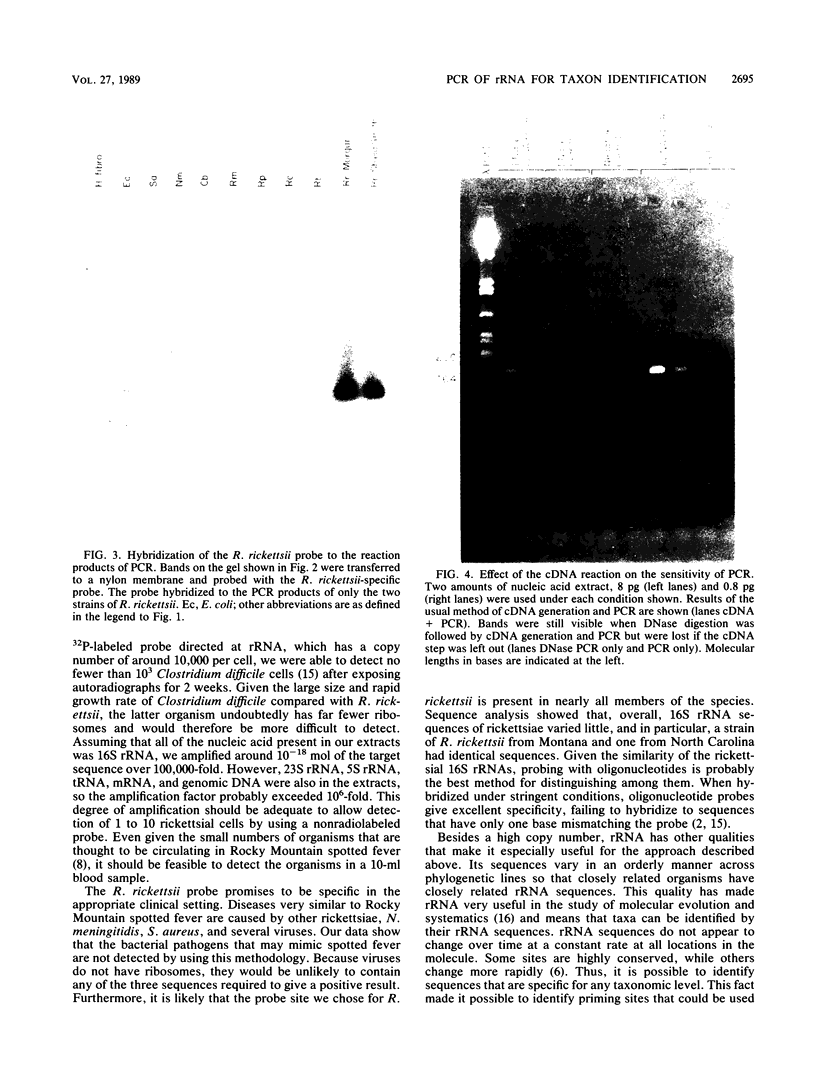
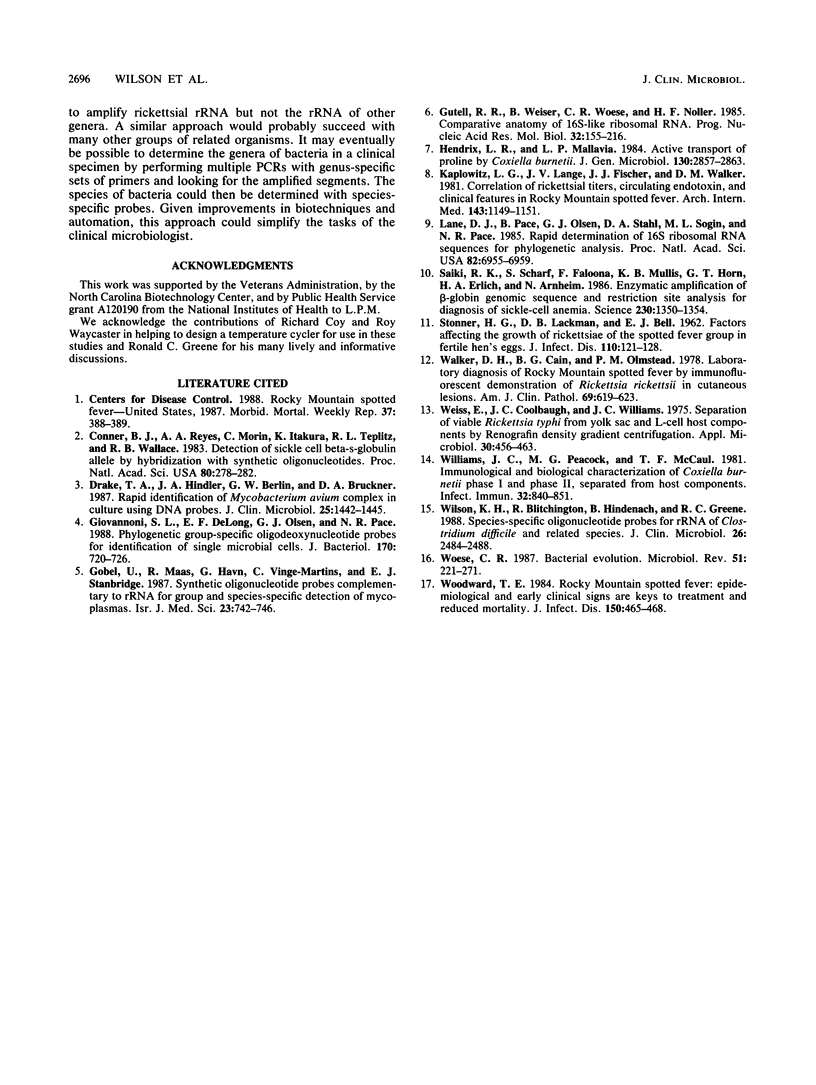
Images in this article
Selected References
These references are in PubMed. This may not be the complete list of references from this article.
- Conner B. J., Reyes A. A., Morin C., Itakura K., Teplitz R. L., Wallace R. B. Detection of sickle cell beta S-globin allele by hybridization with synthetic oligonucleotides. Proc Natl Acad Sci U S A. 1983 Jan;80(1):278–282. doi: 10.1073/pnas.80.1.278. [DOI] [PMC free article] [PubMed] [Google Scholar]
- Drake T. A., Hindler J. A., Berlin O. G., Bruckner D. A. Rapid identification of Mycobacterium avium complex in culture using DNA probes. J Clin Microbiol. 1987 Aug;25(8):1442–1445. doi: 10.1128/jcm.25.8.1442-1445.1987. [DOI] [PMC free article] [PubMed] [Google Scholar]
- Giovannoni S. J., DeLong E. F., Olsen G. J., Pace N. R. Phylogenetic group-specific oligodeoxynucleotide probes for identification of single microbial cells. J Bacteriol. 1988 Feb;170(2):720–726. doi: 10.1128/jb.170.2.720-726.1988. [DOI] [PMC free article] [PubMed] [Google Scholar]
- Gutell R. R., Weiser B., Woese C. R., Noller H. F. Comparative anatomy of 16-S-like ribosomal RNA. Prog Nucleic Acid Res Mol Biol. 1985;32:155–216. doi: 10.1016/s0079-6603(08)60348-7. [DOI] [PubMed] [Google Scholar]
- Göbel U., Maas R., Haun G., Vinga-Martins C., Stanbridge E. J. Synthetic oligonucleotide probes complementary to rRNA for group- and species-specific detection of mycoplasmas. Isr J Med Sci. 1987 Jun;23(6):742–746. [PubMed] [Google Scholar]
- Hendrix L., Mallavia L. P. Active transport of proline by Coxiella burnetii. J Gen Microbiol. 1984 Nov;130(11):2857–2863. doi: 10.1099/00221287-130-11-2857. [DOI] [PubMed] [Google Scholar]
- Kaplowitz L. G., Lange J. V., Fischer J. J., Walker D. H. Correlation of rickettsial titers, circulating endotoxin, and clinical features in Rocky Mountain spotted fever. Arch Intern Med. 1983 Jun;143(6):1149–1151. [PubMed] [Google Scholar]
- Lane D. J., Pace B., Olsen G. J., Stahl D. A., Sogin M. L., Pace N. R. Rapid determination of 16S ribosomal RNA sequences for phylogenetic analyses. Proc Natl Acad Sci U S A. 1985 Oct;82(20):6955–6959. doi: 10.1073/pnas.82.20.6955. [DOI] [PMC free article] [PubMed] [Google Scholar]
- STOENNER H. G., LACKMAN D. B., BELL E. J. Factors affecting the growth of rickettsias of the spotted fever group in fertile hens' eggs. J Infect Dis. 1962 Mar-Apr;110:121–128. doi: 10.1093/infdis/110.2.121. [DOI] [PubMed] [Google Scholar]
- Saiki R. K., Scharf S., Faloona F., Mullis K. B., Horn G. T., Erlich H. A., Arnheim N. Enzymatic amplification of beta-globin genomic sequences and restriction site analysis for diagnosis of sickle cell anemia. Science. 1985 Dec 20;230(4732):1350–1354. doi: 10.1126/science.2999980. [DOI] [PubMed] [Google Scholar]
- Walker D. H., Cain B. G., Olmstead P. M. Laboratory diagnosis of Rocky Mountain spotted fever by immunofluorescent demonstration of Rickettsia in Cutaneous lesions. Am J Clin Pathol. 1978 Jun;69(6):619–623. doi: 10.1093/ajcp/69.6.619. [DOI] [PubMed] [Google Scholar]
- Weiss E., Coolbaugh J. C., Williams J. C. Separation of viable Rickettsia typhi from yolk sac and L cell host components by renografin density gradient centrifugation. Appl Microbiol. 1975 Sep;30(3):456–463. doi: 10.1128/am.30.3.456-463.1975. [DOI] [PMC free article] [PubMed] [Google Scholar]
- Williams J. C., Peacock M. G., McCaul T. F. Immunological and biological characterization of Coxiella burnetii, phases I and II, separated from host components. Infect Immun. 1981 May;32(2):840–851. doi: 10.1128/iai.32.2.840-851.1981. [DOI] [PMC free article] [PubMed] [Google Scholar]
- Wilson K. H., Blitchington R., Hindenach B., Greene R. C. Species-specific oligonucleotide probes for rRNA of Clostridium difficile and related species. J Clin Microbiol. 1988 Dec;26(12):2484–2488. doi: 10.1128/jcm.26.12.2484-2488.1988. [DOI] [PMC free article] [PubMed] [Google Scholar]
- Woese C. R. Bacterial evolution. Microbiol Rev. 1987 Jun;51(2):221–271. doi: 10.1128/mr.51.2.221-271.1987. [DOI] [PMC free article] [PubMed] [Google Scholar]
- Woodward T. E. Rocky Mountain spotted fever: epidemiological and early clinical signs are keys to treatment and reduced mortality. J Infect Dis. 1984 Oct;150(4):465–468. doi: 10.1093/infdis/150.4.465. [DOI] [PubMed] [Google Scholar]



